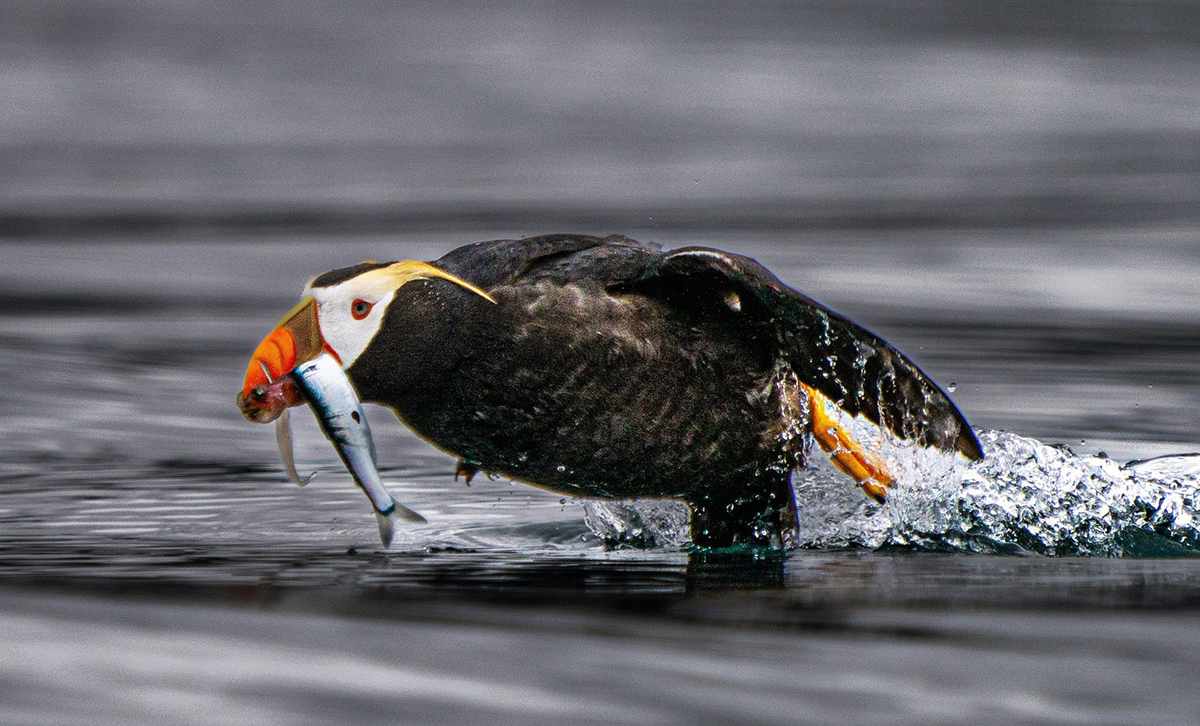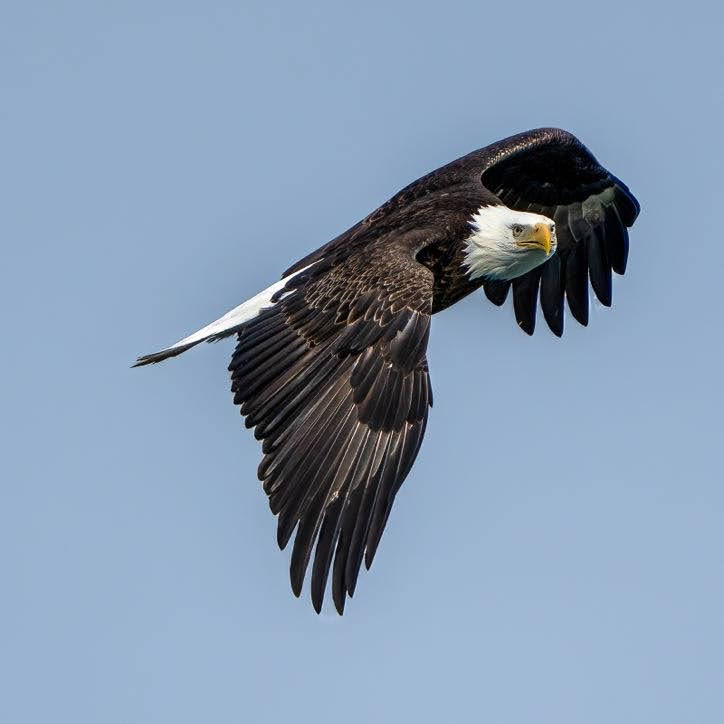 Alaska is home to more than 470 species of birds. While some birds stay in Alaska year-round, most migrate to spend different portions of the year in their nesting and wintering grounds. Birds that migrate from Alaska pass through almost every other US state, including Hawaii! These migrations can take them to Canada, Central America, South America, and even Asia.
Alaska is home to more than 470 species of birds. While some birds stay in Alaska year-round, most migrate to spend different portions of the year in their nesting and wintering grounds. Birds that migrate from Alaska pass through almost every other US state, including Hawaii! These migrations can take them to Canada, Central America, South America, and even Asia.
The state bird of Alaska is the Willow Ptarmigan. They are an arctic species of grouses and they change color depending on the season to help them hide from predators. In summer they are light brown to camouflage with the tundra, and in winter they turn white to blend in with the snow. Willow Ptarmigan also have feathered toes!
This blog explores some of the beautiful birds of Alaska that you might see on our tours.
Horned Puffin
These charismatic little birds are mainly found on islands around the coast of Alaska, often hanging out with their cousins, the Tufted Puffins. The “horns” that give them their name are small fleshy spikes that extend above the eyes of breeding adults. They’re very hardy birds, and spend the winter in the middle of the ocean before coming back to land for the breeding season. Horned Puffins often nest on cliffs; this is unlike other species of Puffin which typically dig burrows to nest in.
They mainly eat small fish that they catch in their colorful bills while they’re swimming underwater, but will sometimes catch squid, crustaceans, and marine worms. They can dive to depths of over 100 feet in pursuit of prey. Their distinctive appearance and playful antics make them a favorite among birdwatchers and nature enthusiasts. With their striking orange bills and comical expressions, Horned Puffins truly embody the spirit of the sea. Their adaptability to a wide variety of prey showcases their resourcefulness in challenging marine environments. Observing these unique birds in their natural habitat is a memorable experience, as they gracefully glide through the water in search of their next meal. The Horned Puffins’ vibrant plumage and captivating behaviors never fail to leave a lasting impression on those lucky enough to witness them in the wild.
Horned Puffins are always a delight to encounter. Often when you see them, they will stare back at you quizzically—you’ll soon realise why Puffins are affectionately called the “clowns of the sea”.

A Horned Puffin sits on a cliff face
Tufted Puffin
Tufted Puffins are another lovely little bird that you may bump into while in Alaska. They’re similar to Horned Puffins, but instead of the colorful bill they have long, yellow plumes of feathers on their head – also known as their “tufts”.
They spend most of the year out at sea only, coming back to land for the breeding season.
Once juvenile Tufted Puffins leave their burrows, they spend the first few years of their lives out at sea. When they reach maturity age at about three years old, they return to breed in the same area where they hatched.
Tufted Puffins lead a captivating life cycle deeply intertwined with the expanses of the sea. Renowned for their adept diving skills, these birds plunge into the depths in pursuit of small fish and crustaceans. Witnessing their synchronized movements underwater is a mesmerizing display, epitomizing their agility and elegance in their oceanic realm. During the breeding season, one can marvel at their elaborate courtship rituals, marked by intricate displays of affection and bonding between partners. The unwavering commitment and resilience of Tufted Puffins to their nesting sites underscore the critical importance of these remote coastal locations for their survival and the perpetuation of their species.

A Tufted Puffin catches a fish from the ocean
Bald Eagle
The national bird of the United States is pretty unmistakable. Not only are they huge, but their characteristic white head makes them easy to identify from other birds of prey. Bald Eagles were appointed as the national emblem of the United States in 1782, and before that, they had been an important symbol for native people for much longer.
These majestic birds are very versatile; they are powerful predators but will also feed on carrion and even steal food from other birds of prey. Over winter, large concentrations can often be found along rivers or reservoirs. At one point, the Bald Eagle population declined due to persecution and pesticides, but environmental protections have helped them to recover.
They typically nest in very tall trees, but being adaptable means that they can sometimes be found nesting close to human settlements. There is a large Bald Eagle’s nest on a pylon right outside the hotel where we stay in Homer during some of our Alaska tours!
Their nests, or aeries, are massive structures constructed with sticks and branches, often weighing hundreds of pounds. These aeries are reused year after year, with the eagles continually adding more materials to them. Bald Eagles are known for their remarkable eyesight, which allows them to spot prey from far distances, even while soaring high in the sky. The courtship ritual of these birds involves intricate aerial displays and calls, reinforcing their bond as a pair. Observing these magnificent creatures in their natural habitat is truly a breathtaking experience that showcases the beauty and grace of the national symbol of the United States.

A Bald Eagle in flight
Black Oystercatcher
Black Oystercatchers inhabit Alaska’s rocky coasts. They get their name from their choice of prey but it’s not just oysters that they enjoy, they will eat various kinds of shellfish and molluscs. They use their long, red bills to pry the shells open, or sometimes use their bills like a jackhammer to crack the shells and get to the prey inside.
The first scientific description of Black Oystercatchers was written by John James Audubon. The genus name Haematopus comes from the Greek for “blood-footed,” a reference to the bird’s pink legs and feet.
Beyond their striking red bills and pink legs, Black Oystercatchers boast a distinct appearance. Their resonant, piping calls reverberate along rugged coastlines, serving as communication tools with partners or alerts for potential dangers. Strong pair bonds are essential for successful breeding and raising chicks in the demanding coastal habitat. Not only adept hunters, but Black Oystercatchers also exhibit devotion as partners and diligence as parents, rendering them a captivating subject for wildlife observation.

A Black Oystercatch on the rocky coasts of Alaska
Black-legged Kittiwake
Black-legged Kittiwakes are small members of the gull family that get their name from the ‘ki-ti-waak’ sound of their calls. Birds typically have four toes on each foot, three facing forward and one facing backwards. On a Black-legged Kittiwake, their hind toe is just a tiny bump, which is how it got its scientific name tridactyla, meaning “three-toed.”
During the breeding season, Black-legged Kittiwakes exhibit fascinating behaviors to protect their nests and offspring. They are known for their impressive aerial displays, where they engage in intricate courtship rituals and defend their territories from intruders. Mates often participate in elaborate bonding rituals, strengthening their relationship and enhancing their breeding success. Additionally, these remarkable seabirds demonstrate remarkable parenting skills, with both parents taking turns to care for their young and ensure their survival in the challenging coastal environment. The dedication and resilience of Black-legged Kittiwakes during the nesting period highlight their adaptability and resourcefulness as they navigate the rugged coastal landscapes to raise the next generation.
During nesting season, Black-legged Kittiwakes are usually seen on narrow cliff ledges where they raise their chicks. They’ve occasionally been seen to nest on buildings and even shipwrecks!

A Black-legged Kittiwake cares for its chick
These are just a few examples of the birds you might come across during your time in Alaska, but there are plenty more! You might see Glaucous-winged Gulls while they wait to eat the scraps of the Salmon that Brown Bears leave behind. Or you could see black and white Pigeon Guillemots with bright red legs, floating on the ocean.
The birdlife is just one of the wildlife wonders that you will encounter while you’re in Alaska—it’s not every day that you can see an eagle just by looking out the window! The wildlife, along with the scenery, the adventure, and the people all combine to make your trip to Alaska truly unforgettable.
Learn about all of Alaska’s wildlife! The Alaskan brown bear life cycle begins with birth in the den during the winter months, where cubs are nurtured by their mother until spring. As spring arrives, the bears emerge from hibernation and embark on a journey of growth and development, learning essential survival skills from their mothers. Throughout the summer and fall, these bears feast on salmon during the annual spawning runs, preparing for the winter ahead, thus completing the cyclical nature of their life in the wilds of Alaska.


